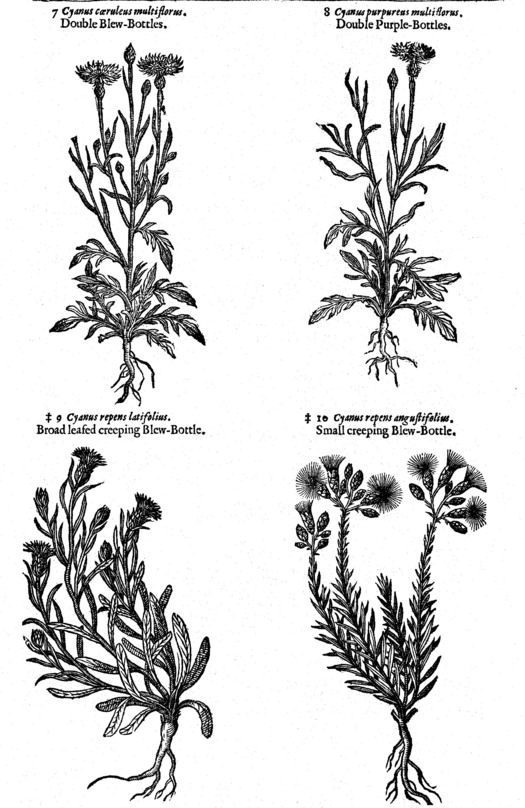
Gerard's Herbal - Part 3
|
|
|
| Fig. 1088. Great Bluebottle (1) |
Fig. 189. Common Bluebottle (2) |
The Description.
1. The great bluebottle hath long leaves, smooth, soft, downy, and sharp pointed: among the leaves rise up crooked, and pretty thick branches, chamfered, furrowed, and garnished with such leaves as are next the ground: on the tops whereof stand fair blue flowers tending to purple, consisting of divers little flowers, set in a scaly husk or knop like those of the Knapweeds: the seed is rough or bearded at one end, smooth at the other, and shining. The root is tough, and long lasting (contrary to the rest of the Corn-flowers) and groweth yearly into new shoots and springs, whereby it greatly increaseth.
2. The common Corn-Flower hath leaves spread upon the ground, of a whitish green colour, somewhat hacked or cut in the edges like those of Corn Scabious: among which riseth up a stalk divided into divers small branches, whereon do grow long leaves of an overworn green colour, with few cuts or none at all. The flowers grow at the top of the stalks, of a blue colour consisting of many small flowers set in a scaly or chaffy head like those of the Knapweeds: the seed is smooth, bright shining, and wrapped in a woolly or flocky matter. The root is small and single, and perisheth when it hath perfected his seed.
3. This Bottle is like the last described in each respect, saving in the colour of the flowers, which are purple, wherein consisteth the difference.
4. The fourth Bottle is also like the precedent, not differing in any point but in the flowers; for as the last before mentioned are of a purple colour, contrariwise these are of a milk white colour, which setteth forth the difference.
5. The Violet-coloured Bottle or Corn-Flower is like the precedent, in stalks, leaves, seeds, and roots: the only difference is, that this bringeth flowers of a violet colour, and the others not so.
6. Variable Corn-Flower is so like the others in stalks, leaves, and proportion, that it cannot be distinguished with words; only the flowers hereof are of two colours mixed together, that is, purple and white, wherein it differeth from the rest.

Fig. 1090. Kinds of Bluebottle (7-10)
7. There is no difference to be found in the leaves, stalks, seed, or roots of this Corn-flower from the other, but only that the flowers hereof are of a fair blue colour, and very double.
8. The eighth Corn-flower is like unto the precedent, without any difference at all, saving in the colour of the flowers, the which are of a bright purple colour, that setteth forth the difference.
9. This from a small root sends up divers creeping branches some foot long, set with long hoary narrow leaves: at the tops of the stalks stand the flowers in scaly heads, like as the other Bluebottles, but of a dark purple colour. The whole plant is very bitter and ungrateful to the taste. Lobel calls this Cyanus repens.
10. This is like the last described, but that the leaves are much smaller or narrower, also the scaly heads of this are of a finer white silver colour: and this plant is not possessed with such bitterness as the former. Lobel calls this Cyanus minimus repens.
The Place.
The first groweth in my garden, and in the gardens of herbarists, but not wild that I know of. The others grow in corn fields among Wheat, Rye, Barley, and other grain: it is sown in gardens, which by cunning to looking doth oft times become of other colours, and some also double, which hath been touched in their several descriptions. The two last grow wild about Montpellier in France.
The Time.
They bring forth their flowers from the beginning of May unto the end of harvest.
The Names.
The old herbarists called it Cyanus flos, of the blue colour which it naturally hath: most of the later sort following the common German name, call it Flos frumentorum, for the Germans name it Corn Blumen: Low Dutch, Corn Bloemen: in French, Blaueole, and Bluet: in Italian, Fior campese, and Bladisiris, i.e. Seris blade["Corn bars"], and Battisecula, or Baptisecula, as though it should be called Blaptisicula["Hurt Sickle"] , because it hindereth and annoyeth the reapers, by dulling and turning the edges of their sickles in reaping of corn: in English it is called Bluebottle, Blue-Blow, Corn-Flower, & Hurt-Sickle. Fabius Columna would have it to be the Papaver spumeum, or heracleum of the ancients.
The Temperature and Virtues.
A. The faculties of these flowers are not yet sufficiently known. Sith there is no use of them in physic, we will leave the rest that might be said to a further consideration: notwithstanding some have thought the common Bluebottle to be of temperature something cold, and therefore good against the inflammation of the eyes, as some think.